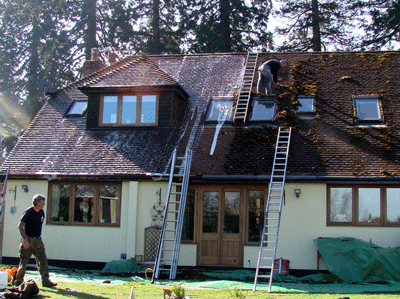Maintaining period properties: How to treat roof moss
Roof moss is an unavoidable problem, particularly on period properties. We explain how it affects your house and the best ways of dealing with roof moss.

When looking at an ageing building, few people cast a critical eye at the state of the roof. The windows are clean, the garden tidy and the interior spotless, but the roof is almost invariably unkempt. Black moulds hide the colour, and moss slowly mats itself in the bonds, so slowly that few take notice.
The encroachment of grime and moss has its own effects: beyond the aesthetic downgrade the fabric of the building is at risk. Doing nothing is ultimately the expensive option. The risk varies with the nature of the roofing material: Thatch and wood shingles are at a more immediate risk of decay. Metals depassivate (lose their corrosion protection) under the acidic releases of lichen and moss. Lead and zinc used in soakers and rainwater disposal will thin down to eventually leak. Clay tiles need to dry between rainfalls to fulfil the promise of durability - if not premature shaling or frost damage may occur. On all material the permanent presence of a bio film is deleterious by increasing capillary creep in laps and interstices. This in turn leads to undetectable moisture ingress.
Generally materials retaining moisture are prone to contamination and combined with winter exposure, porous materials such as concrete tiles will become a good host for moulds such as A. Niger, then algae, followed by moss and lichen. As the bio film becomes established, the moistures are more permanent, and the cycle accelerates. Architects do not seem to consider this in their choice of roof material: This was of no consequence in the days of acidic rain, but cleaner air results in nature reclaiming its place in unforeseen ways.

There is no easy answer to the return of nature: Excessive moss has to be removed by hand. Mechanical means used on the ground are ill adapted to a pitch roof. Jetting causes irremediable erosion to the surface. As a result the un-wanted host returns with a vengeance, only to hide the uneven, permanent discolorations of the roofing tiles.
After clearing the roof from the bulky growth the next and final step is to spray the area with a dedicated anti algal wash. The right product, will kill the remaining biological life at the surface and, most importantly, in laps and interstices. The dead bio film will soon loosen under diurnal cycles, helped by the wind, rain, heat and frost. Self cleansing is a lengthy affair - months in most cases with latent effects stretching over a period of two or three years. The roof will become cleaner with the change of seasons and reveal its original colour and texture.
There is no known preventative measure of any durability. Clear hydrophobic resins degrade under UV in a matter of months. The same causes - substrate porosity and sun exposure - will have the same effects, at the same rate. This however is slow and a roof treatment is to be regarded as decennial maintenance. Further maintenance will not be as heavy as the first clean, if carried out as or before the surface contamination triggers the condition for accelerated growth.
On the continent, antiseptic roof shampoo has been standard practice for decades. Roofing firms offer it as a standard way of finishing remedial work and as preparation to fitting out solar panels. In Britain the practice is expanding quickly: The process has been adapted to suit the more demanding climate of the British Isles.
Exquisite houses, the beauty of Nature, and how to get the most from your life, straight to your inbox.
Thames Valley Specialist Products is a small business specialising in the roof treatment process : The Mossgo Roof System. The process includes the use of bespoke equipment for the delivery of the biocidal wash by qualified roofing firms. The company operates in Britain and Ireland. www.roofclean.co.uk hosts a wealth of information on roof maintenance treatment. Telephone 01628 687 022 (info@roofclean.co.uk).

This is an article from ProjectBook which provides a wide range of information for the conservation, restoration, care and repair of period and listed buildings. Thames Valley Specialist Products is featured in our specialist Products Directory. Updated daily with new content, the website features the Heritage Register which contains over 500 vetted craftsmen, contractors and consultants from all over the UK, a products directory, informative articles, current news, events and more. For more information, visit www.projectbook.co.uk
Country Life is unlike any other magazine: the only glossy weekly on the newsstand and the only magazine that has been guest-edited by His Majesty The King not once, but twice. It is a celebration of modern rural life and all its diverse joys and pleasures — that was first published in Queen Victoria's Diamond Jubilee year. Our eclectic mixture of witty and informative content — from the most up-to-date property news and commentary and a coveted glimpse inside some of the UK's best houses and gardens, to gardening, the arts and interior design, written by experts in their field — still cannot be found in print or online, anywhere else.

